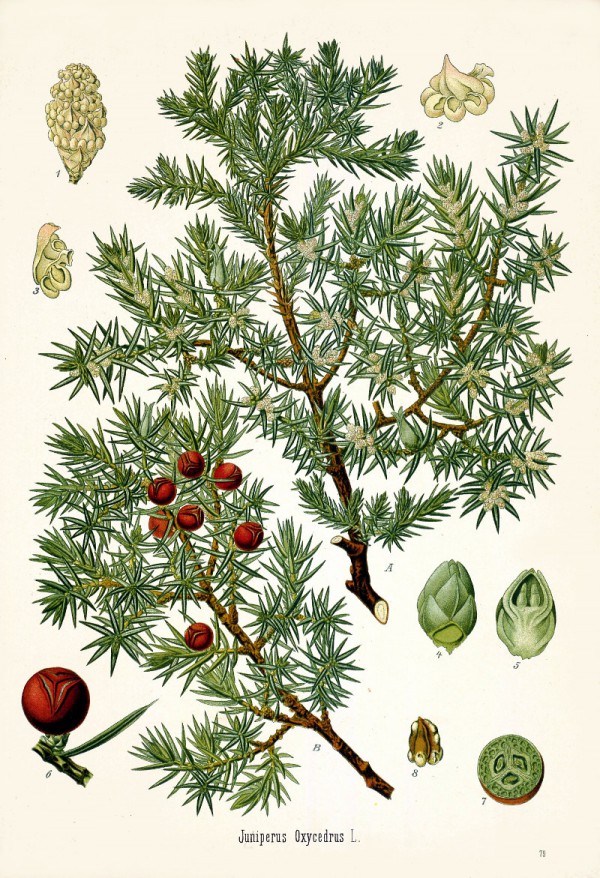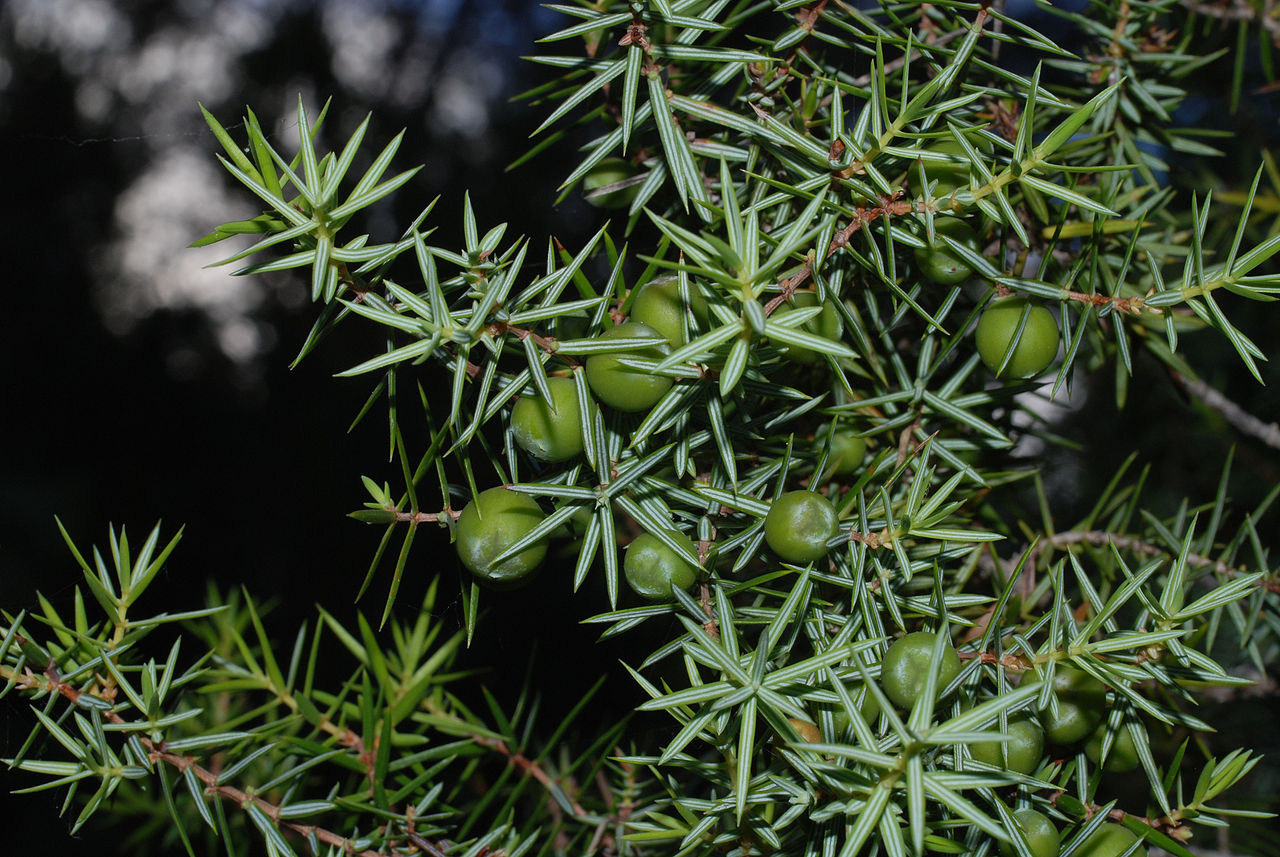Dies ist eine alte Version des Dokuments!
Juniperus oxycedrus L. - Cupressaceae - (western) prickly juniper, cade juniper, Stech-Wacholder, Zedern-Wacholder
Dioecious shrub or tree 6-8m high, native in the Mediterranean; bark gray to brown-red; needles sharp, in groups of three, 1-2cm long, upper side with 2 distinct stomatal lines; fruit red, spherical, 1cm in diameter, with three seeds.
„Cade oil is the essential oil obtained through destructive distillation of the wood of this shrub. It is a dark, aromatic oil with a strong smoky smell which is used in some cosmetics and (traditional) skin treatment drugs, as well as incense.“ https://en.m.wikipedia.org/wiki/Juniperus_oxycedrus
The essential oil of J.oxycedrus wood of Turkey origin consisted mainly of sesquiterpenes. Among the sesquiterpenes, widdrene, widdrol, α-cedrol and caryophyllene were the main compounds. The monoterpene thymoquinone, a characteristic but minor compound of juniper woods, reached 1.8%.
[The composition of volatile extractives from the wood of Juniperus excelsa, Juniperus foetidissima and Juniperus oxycedrus. Uçar, G., Balaban, M., Holz als Roh-und Werkstoff, Vol.60(5), 2002, 356-362]
„Supercritical carbon dioxide extraction of the leaves and berries of Juniperus oxycedrus L. ssp. oxycedrus, coupled with a two-stage separation, allowed the entrapment of cuticular waxes in the first separator (90 bar, −10 °C), thereby allowing pure essential oils to be collected in the second separator (15 bar, 10 °C). An extraction carried out on a charge of leaves, at 90 bar and 50 °C, gave a yield of 0.8% (w/w) with respect to the charged material, of an oil whose major constituents were germacrene D (15.9%), manoyl oxide (10.2%) and 1-epi-cubenol (5.4%). The berry oil obtained, at the same pressure and temperature as those for the leaves, gave a yield of 0.45% (w/w) and was composed chiefly of germacrene D (13.8%), α-pinene (10.5%) and β-myrcene (8.1%). At a constant temperature of 50 °C, different extraction pressures (80, 90 and 100 bar) were tested in order to obtain the juniper wood essential oil. The extraction yield depended strongly on the extraction pressure, reaching a maximum of 14.7% (w/w) at 100 bar. The main constituents in the extract were δ-cadinene, calamenene, cubenol and 1-epi-cubenol. Hydrodistillation of the wood of J. oxycedrus gave a yield of 11.0% (w/w) of essential oil, with a reduced level of sesquiterpene hydrocarbons and an enhanced amount of oxygenated sesquiterpenes, with respect to the oil obtained by supercritical carbon dioxide extraction. The extracts obtained at different pressures were tested for cytotoxicity, antiviral and antimicrobial activities. The results showed that the extracts of leaves and berries obtained at 200 bar were cytotoxic against different cell lines used to support virus growth. As far as antiviral activiy is concerned, some of the extracts were active against a single-stranded RNA+ virus (Poliovirus-1). When tested for antimicrobial activity, none of the samples were shown to be active.“
[Extraction of Juniperus oxycedrus ssp. oxycedrus essential oil by supercritical carbon dioxide: influence of some process parameters and biological activity. Marongiu, B., Porcedda, S., Caredda, A., De Gioannis, B., Vargiu, L., Flavour and fragrance journal, Vol.18(5), 2003, 390-397]
„J. oxycedrus ssp. oxycedrus berry oil was characterised by high contents of α-pinene (27.4%) and β-myrcene (18.9%). Other important compounds were α-phellandrene (7.1%), limonene (6.7%), epi-bicyclosesquiphellandrene (2.3%) and δ-cadinene (2.2%) while, in the wood oil, δ-cadinene (14.5%) is a major main component, together with cis-thujopsene (9.2%) and α-muurolene (4.9%).“
[Comparative chemical composition, antioxidant and hypoglycaemic activities of Juniperus oxycedrus ssp. oxycedrus L. berry and wood oils from Lebanon., Loizzo, M.R., Tundis, R., Conforti, F., Saab, A.M., Statti, G.A., Menichini, F., Food Chemistry, 105(2), 2007, 572-578]
The leaf oil of Juniperus oxycedrus subsp.macrocarpa (0.03-0.13%) from Turkey contained mainly manoyl oxide (7.7-21.9%), α-pinene (7.2-11.1%), α-cedrol (2.3-9.7%), widdrene (2.1-5.7%), α-muurolene (4.1-4.8%), trans-verbenol (1.7-4.3%), germacrene D (1.5-4.1%), δ-cadinene (3.2-3.8 %), α-campholene aldehyde (1.7-3.2%), trans-pinocarveol (1.5-3.0%), cubebol (1.4-2.4%), caryophyllene oxide (1.5-1.9%), δ-cadinene (1.0-1.8%),β-caryophyllene (0.7-1.8%), and epi-cubebol (1.0-1.4%).
[Sezik, E., et al. „Composition of the essential oils of Juniperus oxycedrus subsp. macrocarpa from Turkey.“ Chemistry of natural compounds 41.3 (2005): 352-354]
The oils of the leaves of 60 individual trees of Juniperus oxycedrus L. growing in four locations in Tunisia were dominated by terpenic hydrocarbons, with α-pinene (27.3-58.0%) as the main component, followed by geranyl acetone (1.9-7.1%), 13-epimanoyl oxide (1.3-6.9%), and eudesma-4(15),7-dien-1-ol (1.3-4.1%).
[Medini, Hanen, et al. „Leaf Essential Oil of Juniperus oxycedrus L.(Cupressaceae) Harvested in Northern Tunisia: Composition and Intra‐Specific Variability.“ Chemistry & biodiversity 7.5 (2010): 1254-1266]
Phenol is the most toxic component of J.oxycedrus wood oil and responsible for the majority of systemic toxic symptoms. „Systemic toxicity is multi visceral and explained by the formation of cytotoxic metabolites (semi-quinone radicals), when the amount ingested absorbed exceeds the capacity of hepatic conjugation… poisoning caused convulsions, collapsus, acute pulmonary oedema, renal failure and hepatotoxicity.“
[Achour, S., Abourazzak, S., Mokhtari, A., Soulaymani, A., Soulaymani, R., & Hida, M. (2011). Juniper tar (cade oil) poisoning in new born after a cutaneous application. BMJ case reports, 2011, bcr0720114427] http://www.ncbi.nlm.nih.gov/pmc/articles/PMC3207742/

Köhler, F.E., Medizinal Pflanzen, vol.3 t.79 (1890)
http://plantgenera.org/species.php?id_species=570731

Juniperus oxycedrus, Sa Talaia ~100m, Ibiza
Wikimedia Commons, Author: Tigerente CC BY-SA 3.0
